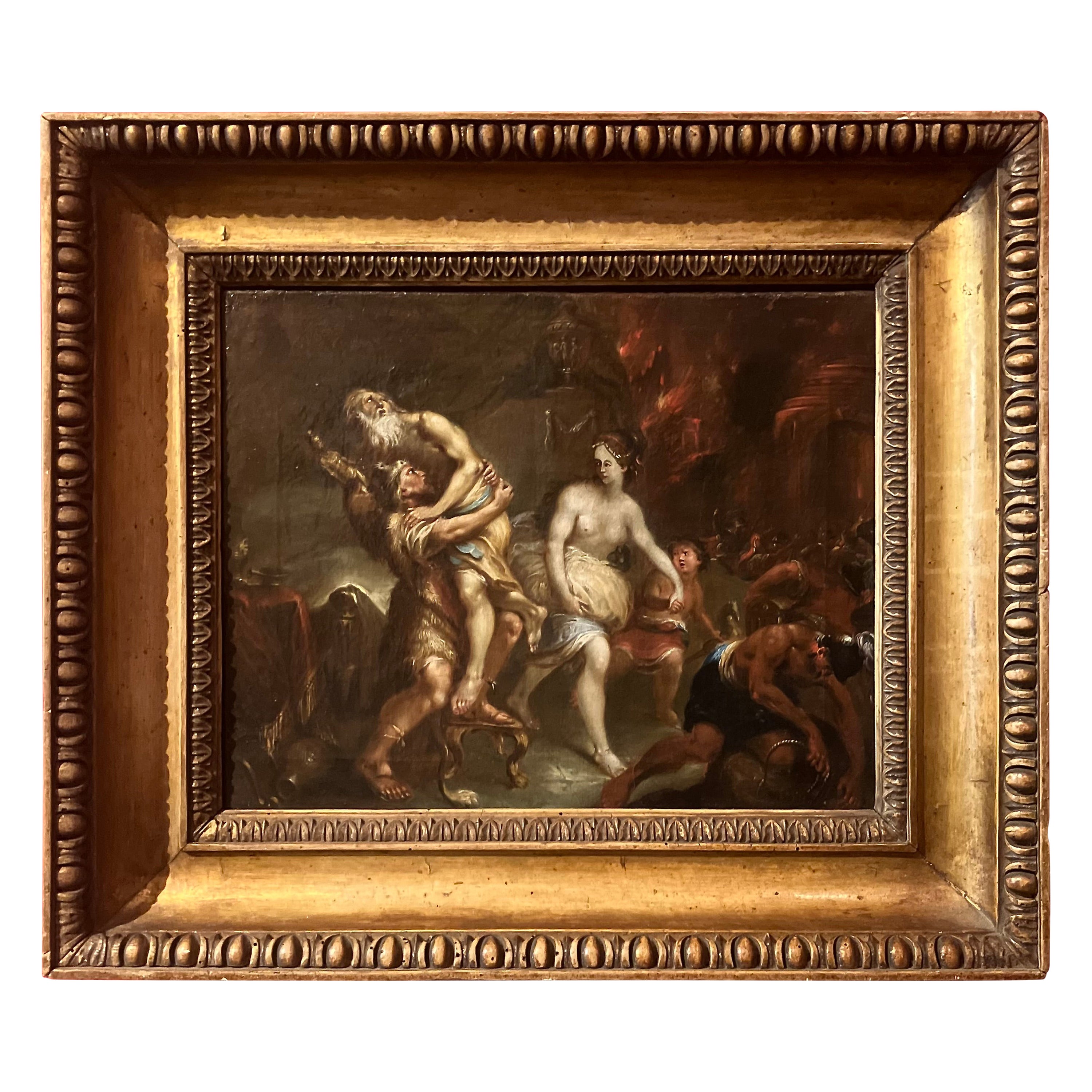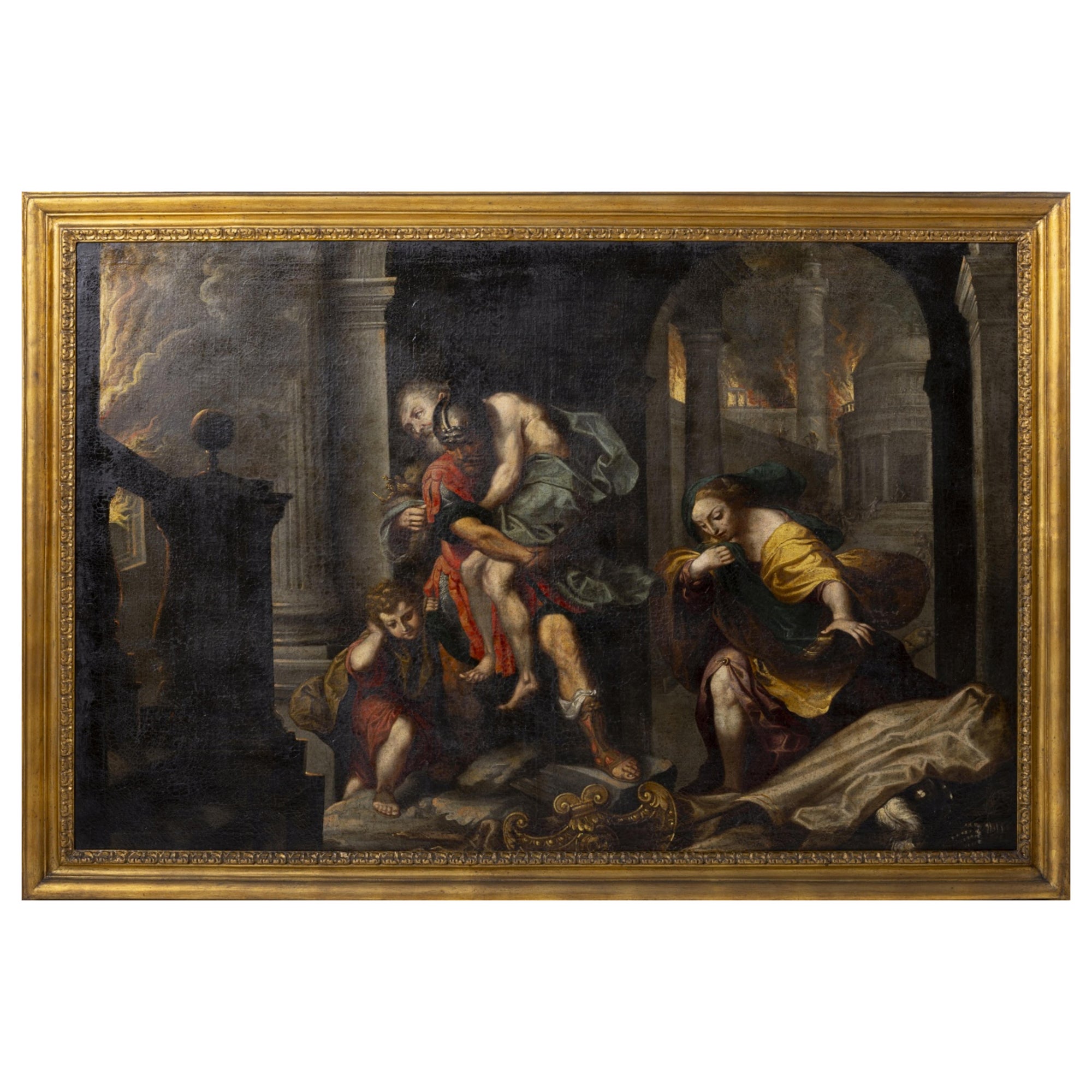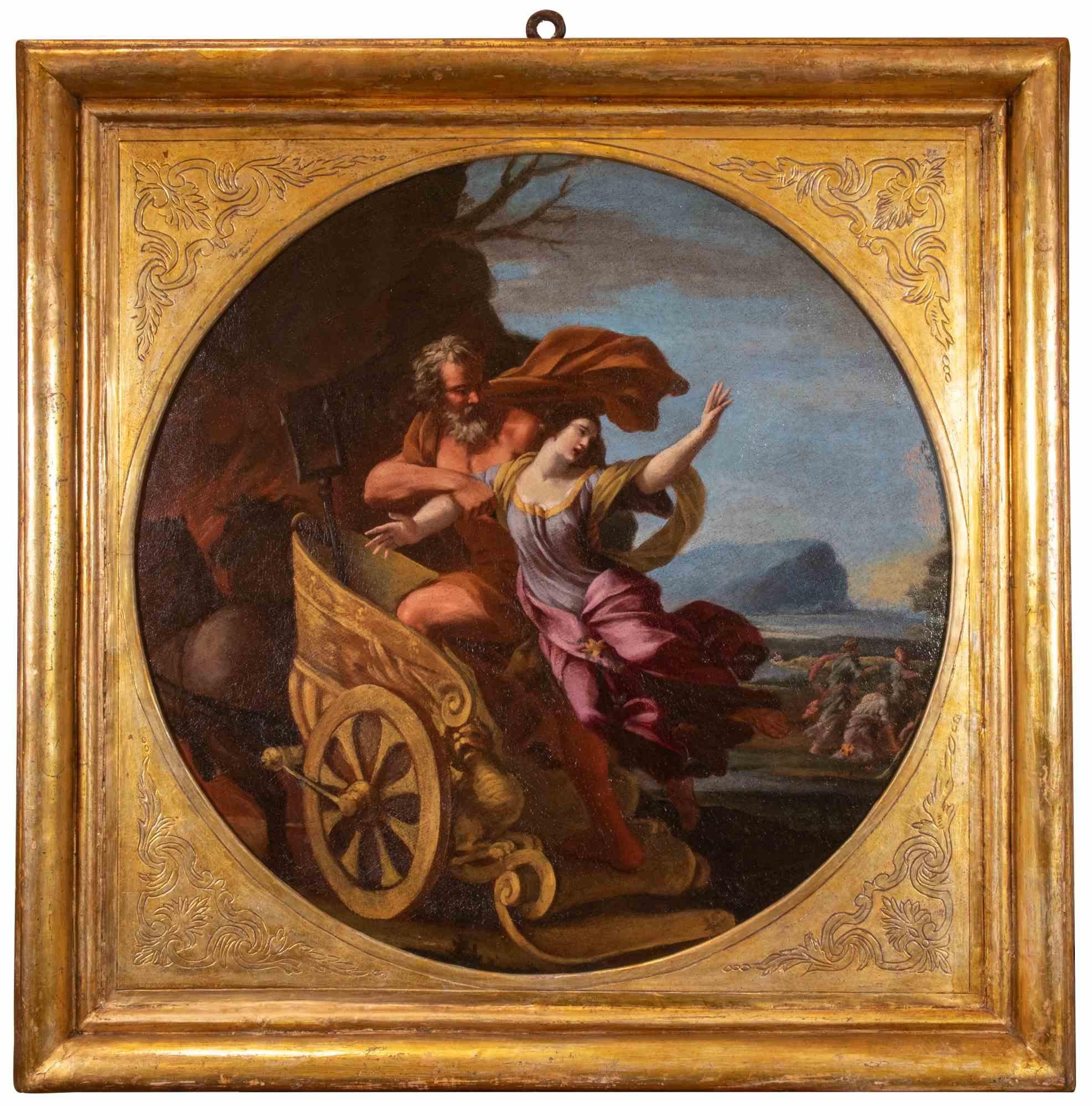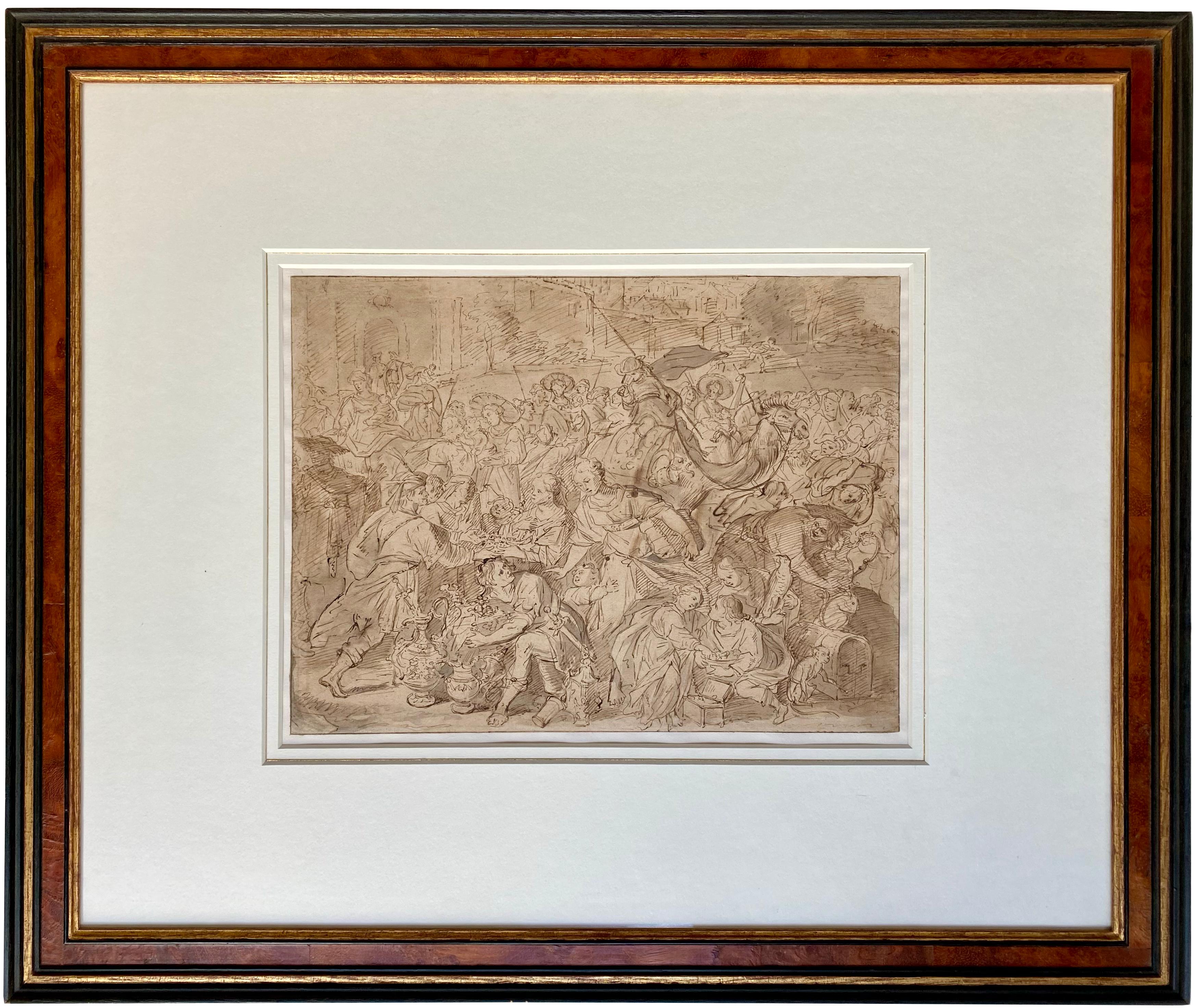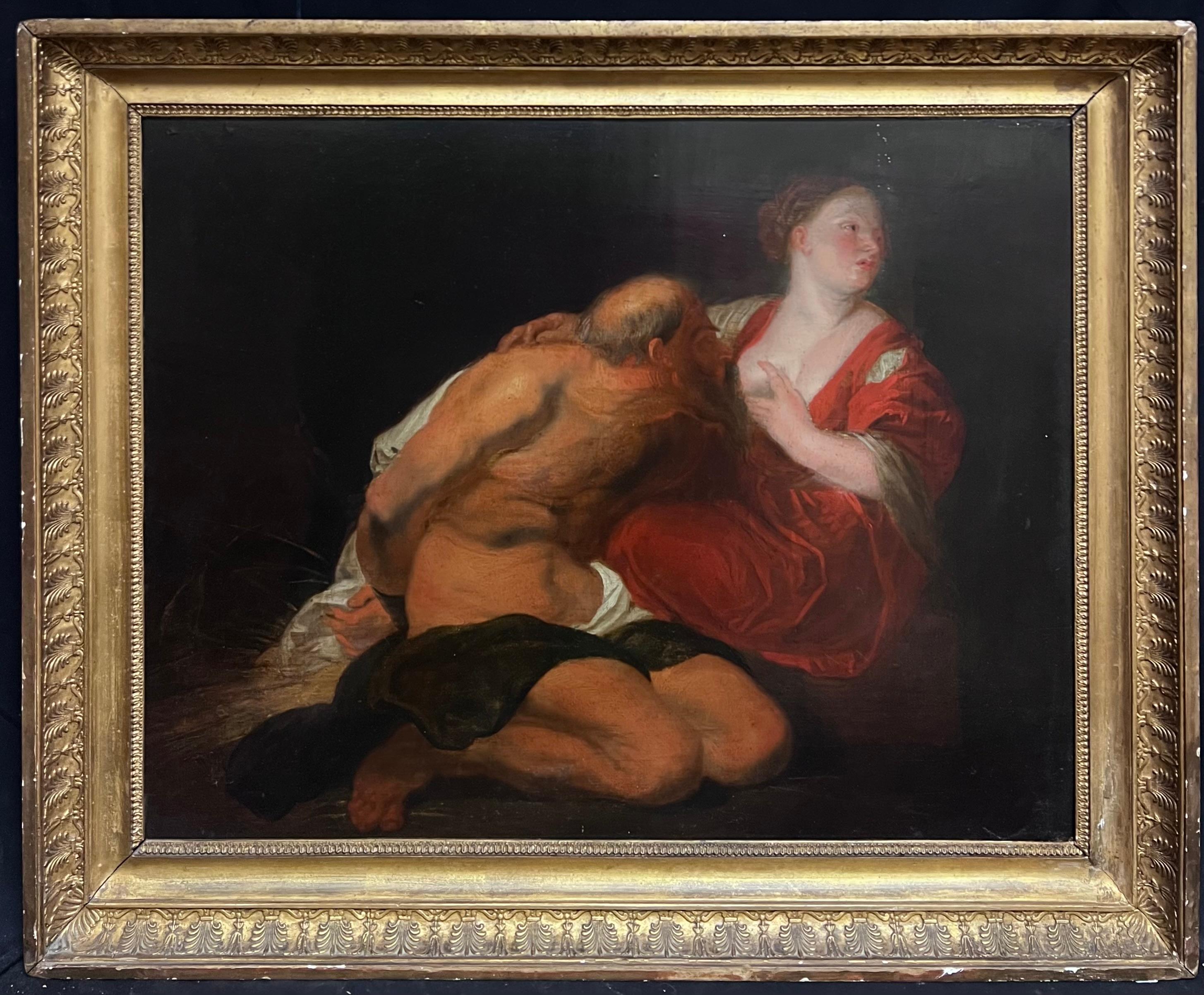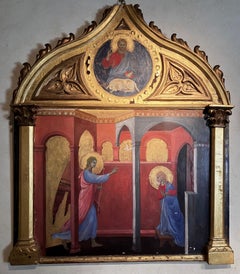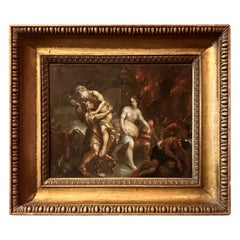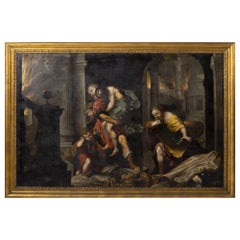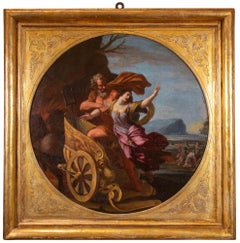Items Similar to Aeneas Fleeing the Burning of Troy, 17th Century Flemish Oil on Canvas Painting
Want more images or videos?
Request additional images or videos from the seller
1 of 18
UnknownAeneas Fleeing the Burning of Troy, 17th Century Flemish Oil on Canvas Painting1600s
1600s
$9,573.62
£7,111.60
€8,000
CA$13,207.48
A$14,518.66
CHF 7,630.34
MX$176,309.36
NOK 95,186.57
SEK 90,182.58
DKK 60,900.14
About the Item
This oil painting on canvas, created by an artist from the 17th Century Flemish School, depicts one of the most significant scenes from Greco-Roman mythology: Aeneas saving his family from the devastating flames of Troy. The artwork captures an extraordinary dramatic moment from Virgil's "Aeneid,"illustrating the heroic and determined escape of Aeneas, carrying his elderly father Anchises on his back, along with his wife Creusa and son Ascanio, from the now-burning city of Troy.
Despite its small size, the canvas contains a large number of characters, objects, and architectural elements that contribute to the dynamism of the scene, alongside a detailed anatomical representation of the figures and a vibrant color palette.
The mastery of chiaroscuro, the layered yet intense brushstrokes, and the use of contrasts and juxtapositions highlight the anguish and determination of the protagonists. The movements, skin tones, and garments, accentuated by the flickering fire, draw us into a pivotal moment for the characters. The other figures populating the majestic architecture seem doomed to be consumed by the destructive flames.
The depiction of urgency and the representation of a crucial moment is successfully executed. The observer is invited to explore the characters' emotions, ranging from fear to hope, through their expressive faces and anatomical poses. The warm tones of the red flames in the background spectacularly contrast with the more delicate colors and cooler hues tones of the figures in the foreground, intensifying the overall visual impact of the artwork.
This painting is a wonderful synthesis of Dutch Baroque painting, a testament to the flourishing Golden Century of the 1600s. With refined technique and compelling storytelling, this painting enriches any artistic collection and serves as a significant historical monument capable of stimulating lasting conversations and appreciation.
Symbolizing human resilience, it evokes the theme of salvation. The figure of Anchises embodies nobility and sacrifice, blending classical roots with the Flemish artistic context. Aeneas's flight represents renewal and cultural continuity, themes cherished by 17th-century artists.
In summary, this painting is a marvel of Flemish Baroque, inviting deep reflections on the human condition and the quest for hope. It exudes a timeless charm, enriching not only your space and collection but also adding aesthetic and cultural value while stimulating valuable artistic and historical conversations.
Condition and Technical Details
The painting is in excellent condition for its age, featuring the original canvas with an interesting and stable craquelé in some areas. The surface is uniform, with bright and saturated colors. It is housed in an elegant carved and gilded wooden frame, decorated with stylized acanthus leaves and deep egg and dart oval carvings.
Dimensions:
With Frame:** H. 50 cm, W. 58 cm, D. 8 cm
Unframed:** H. 34 cm, W. 42 cm
- Creation Year:1600s
- Dimensions:Height: 22.84 in (58 cm)Width: 19.69 in (50 cm)Depth: 3.15 in (8 cm)
- Medium:
- Movement & Style:
- Period:
- Condition:
- Gallery Location:Firenze, IT
- Reference Number:Seller: Galleria Antonio Esposito di Chiara Esposito, Firenze, Italy1stDibs: LU1011114883532
About the Seller
5.0
Vetted Professional Seller
Every seller passes strict standards for authenticity and reliability
Established in 1950
1stDibs seller since 2018
18 sales on 1stDibs
- ShippingRetrieving quote...Shipping from: Firenze, Italy
- Return Policy
Authenticity Guarantee
In the unlikely event there’s an issue with an item’s authenticity, contact us within 1 year for a full refund. DetailsMoney-Back Guarantee
If your item is not as described, is damaged in transit, or does not arrive, contact us within 7 days for a full refund. Details24-Hour Cancellation
You have a 24-hour grace period in which to reconsider your purchase, with no questions asked.Vetted Professional Sellers
Our world-class sellers must adhere to strict standards for service and quality, maintaining the integrity of our listings.Price-Match Guarantee
If you find that a seller listed the same item for a lower price elsewhere, we’ll match it.Trusted Global Delivery
Our best-in-class carrier network provides specialized shipping options worldwide, including custom delivery.More From This Seller
View AllItalian Oil on Alabaster Painting Pompeian Interior Scene in Ormolu Frame
Located in Firenze, IT
This Italian 19th century oil on alabastrer painting depicts an opulent interior in full ancient neoclassical Pompeian style with people festing.
The figurative inner scene is painted on a rectangular alabaster slab and housed in a wonderful giltbronze frame resting on casted arrow feet.
This is a single section of a bigger surtout de table. You can now use it as a decorative centrepiece on a table or on a console or turn it into a wall decoration. We can provide framing options in this case.
The characters enjoy a rich banquet in an elaborate interior, the room renderings...
Category
19th Century Italian School Interior Paintings
Materials
Alabaster, Bronze
Italian Renaissance Style Tempera on Gold Ground Panel Painting the Annunciation
Located in Firenze, IT
This Italian tempera painted on gilt wood gold ground panel is a Tuscan religious artwork in the style of late Renaissance - early Gothic period. The sc...
Category
19th Century Renaissance Figurative Paintings
Materials
Gold Leaf
Italian 18th Century Oval Religious Oil on Canvas Painting with Saint Dominic
By Francesco de Mura
Located in Firenze, IT
This beautiful Italian 18th Century old masters oil painting on oval canvas with giltwood frame is attributed to Solimena and features a religious scene.
In this splendid oval-shaped painting are depicted Saint Dominic...
Category
18th Century Old Masters Figurative Paintings
Materials
Canvas, Oil
Oil on Canvas Painting Portrait of the Italian Noble Family of Zanardi Count
By Lucia Casalini Torelli
Located in Firenze, IT
This museum quality old master oil on canvas formal portrait painting depicting the family of the Count Zanardi is signed by the artist- the female painter Lucia Casalini Torelli- and published in a book dedicated to Casalini Torelli’s workshop and academy.
This palatial masterpiece artwork comes directly from the ancient Villa Maraini Guerrieri - Palidano di Gonzaga (Mantua), an historic Italian heritage building owned by the descendants of the family portrayed for more than two centuries, until 1998.
The big scale of this oil on canvas masterpiece painting states the relevance of Lucia Casalini Torelli as a painter. The present artwork is a formal family portrait painting that aim to introduce the characters depicted according to their social role in the society. The noble family is all gathered under a loggia overlooking a park, the landscape in the background is partially covered by a beautiful red cloth on the right side.
The father stands up and holds the hand of his eldest son, proudly introducing his future heir. The son wears a light-blue dress and red boots, he is depicted in a serious pose holding a black tricorn hat under his arm and a rapier sword on his belt.
The mother wears an elegant gold and dark green brocade dress, she is sitting with her youngest daughter on her knees while her second son is by her side. The little daughter wears a lovely long red and dress with white lace and holds an apple on her hand. The son stands next to his mother and is dressed in a brown priestly clothes.
This palatial old masters piece was probably painted in 1740 due to the similarities with Cardinal Doria’ s portrait, now on display at the Doria Palace Museum, the official residence of the Prince of Genoa.
The painting features original canvas (“prima tela”) and antique original patina, it is in excellent overall condition considering the age, use and its large scale. A formal detailed condition report and the results of the inspection with the UV lamp accompanied by photos is available on request.
As well as for its exceptional quality and quite perfect state of conservation, this painting is particularly important and even more valuable both for the artist who painted it and for its absolutely exclusive provenance.
Lucia painted the most prominent and powerful noble families of her time, the location of these paintings is unknown to the art market as it is extremely likely that the portraits are still kept in private collections.
Furthermore, Lucia was one of the most appreciated artists of her time, so important that she was admitted as a member of the academy at a time when women were forbidden to attend these studies.
In 1706, Felice Torelli...
Category
18th Century Old Masters Portrait Paintings
Materials
Canvas, Oil
Italian Painter’s Portrait Engravings on Laid Paper on Canvas in Ebonized Frames
Located in Firenze, IT
These beautiful Italian 18th Centruy engravings on laid paper feature the portrait of two famous Italian painters: Veronese and Guido Reni. They were engraved by Pier Antonio Pazzi a...
Category
18th Century Baroque Portrait Prints
Materials
Cotton Canvas, Laid Paper, Engraving
J. Brunner 1869 Oil on Canvas Austrian Landscape with Lake and Mountain Painting
Located in Firenze, IT
This very fine quality 19th century oil on canvas in dark brown wood frame with gold leaves details throughout is signed by Joseph Brunner (Vienna 1826-...
Category
19th Century Romantic Landscape Paintings
Materials
Canvas, Wood, Oil
You May Also Like
Aeneas Fleeing the Burning of Troy, 17th Century Flemish Oil on Canvas Painting
Located in Firenze, IT
This oil painting on canvas, created by an artist from the 17th Century Flemish School, depicts one of the most significant scenes from Greco-Roman mythology: Aeneas saving his famil...
Category
Antique 17th Century Dutch Baroque Paintings
Materials
Giltwood, Paint
WILLEM VAN MIERIS (1662-1747)"Aeneas flees from burning Troy"by Federico Barocci
Located in Madrid, ES
WILLEM VAN MIERIS CIRCLE (1662-1747)
"Aeneas flees from burning Troy" by Federico Barocci
Oil on canvas.
Restorations.
Dim.: 117 x 170 cm
good condi...
Category
Antique 17th Century Dutch Baroque Paintings
Materials
Paint
18th Century Neoclassical Oil Painting of the Trojan War: Briseis & Achilles
By James Thornhill
Located in London, GB
James Thornhill (1674-1735)
Oil on canvas
12 x 14 inches;
16 ½ x 18 ½ in. Inc. frame
The subject matter and inclusion of herms on both sides shows the influence of Louis...
Category
Early 18th Century Old Masters Figurative Paintings
Materials
Canvas, Oil
The Abduction of Persephone by Hades - Oil Paint - Mid 17th Century
Located in Roma, IT
Oil on canvase realized by Giovanni Francesco Romanelli, so called "Il Viterbese" (1610-1662).
It depicts the famous abduction of Persephone, daughter of Zeus and Demeter, by Hades....
Category
Mid-17th Century Baroque Figurative Paintings
Materials
Oil
'The Departure of the Israelites from Egypt' by Frans Francken the Younger
Located in Knokke, BE
Frans Francken the Younger
1581 - Antwerp - 1642
Flemish Painter
'The Departure of the Israelites from Egypt – The Exodus', c. 1610 - 1620
Medium: pen in sepia on paper
Dimensions: mage size 26 x 34,5 cm, frame size 55 x 65,5 cm
Biography: Frans Francken the Younger, born in Antwerp in 1581 and passing away on May 6, 1642, also in Antwerp, was a distinguished Flemish painter. He is recognized as the most prominent and productive member of the renowned Francken family of artists. Francken explored a wide range of subjects, creating large altarpieces for churches and producing smaller works depicting historical, mythological, and allegorical scenes. Notably, his depictions of collectors’ cabinets established a popular new genre of art during his era. He was known for collaborating with other artists, enriching their works with his skilled renderings of figures and narrative elements, complementing specialists in landscape, architectural scenes, and floral still-life painting.
Francken was born to Frans Francken the Elder and Elisabeth Mertens. His father was a pupil of Antwerp’s leading history painter, Frans Floris, and a significant creator of altarpieces in Flanders during his time. Francken received his artistic training under the guidance of his father. Additionally, it is possible that Frans and his brother, Hieronymus Francken II, received further instruction in the workshop of their uncle, Hieronymus Francken I, in Paris.
A versatile artist, Francken made significant contributions to various genres within Flemish art, introducing new themes and subjects. Many of his works comprised small-scale historical, allegorical, and biblical cabinet paintings, often emphasizing figures. He is credited with either inventing or popularizing several novel themes that gained popularity in Flemish painting, including genre scenes featuring monkeys (also known as singeries) and Kunstkammer or gallery paintings, presenting a plethora of natural and artistic treasures against a neutral wall. Francken introduced various other unconventional themes that later gained traction, such as the ‘Triumphal Procession of Amphitrite’ and ‘Croesus and Solon.’ He also produced a series of paintings depicting witches and witchcraft, including portrayals of witches’ sabbats.
His remarkable paintings are held in the collections of numerous major museums throughout Europe. Francken specialized in rendering the human figure, as evidenced by etched and engraved portraits of the artist by Anthony van Dyck (after Peter Paul Rubens), identifying him with the Latin inscription: ‘ANTVERIÆ PICTOR HVMANARVM FIGVRARVM’ (Figure painter of Antwerp). He was frequently invited to contribute figures to compositions by other esteemed artists, including landscape artists such as Tobias Verhaecht, Abraham Govaerts, and Joos de Momper...
Category
Early 17th Century Baroque Interior Paintings
Materials
Pen, Paper
Fine 17th Century Flemish Baroque Oil Painting Roman Charity Large Wood Panel
Located in Cirencester, Gloucestershire
Roman Charity
Flemish Baroque period, first half 17th century
circle of Peter Paul Rubens
oil on wood panel, framed
framed: 24.5 x 30 inches
panel: 20 x 26 inches
Provenance: Private...
Category
17th Century Baroque Figurative Paintings
Materials
Oil
More Ways To Browse
Flemish Baroque
Historical Monuments
17th Century Flemish School
Fremin Gallery
Girl Cat Painting
Horace Pippin
Jan Balet
Korean Moon Jar
Painted Gucci
Painting By Women Artists
Pulp Magazine
Resurrection Paintings
Safed Israel
Surfer Painting
Taro Okamoto
Vintage Bicycle Painting
Vintage Carousel Painting
Woman With Guitar
